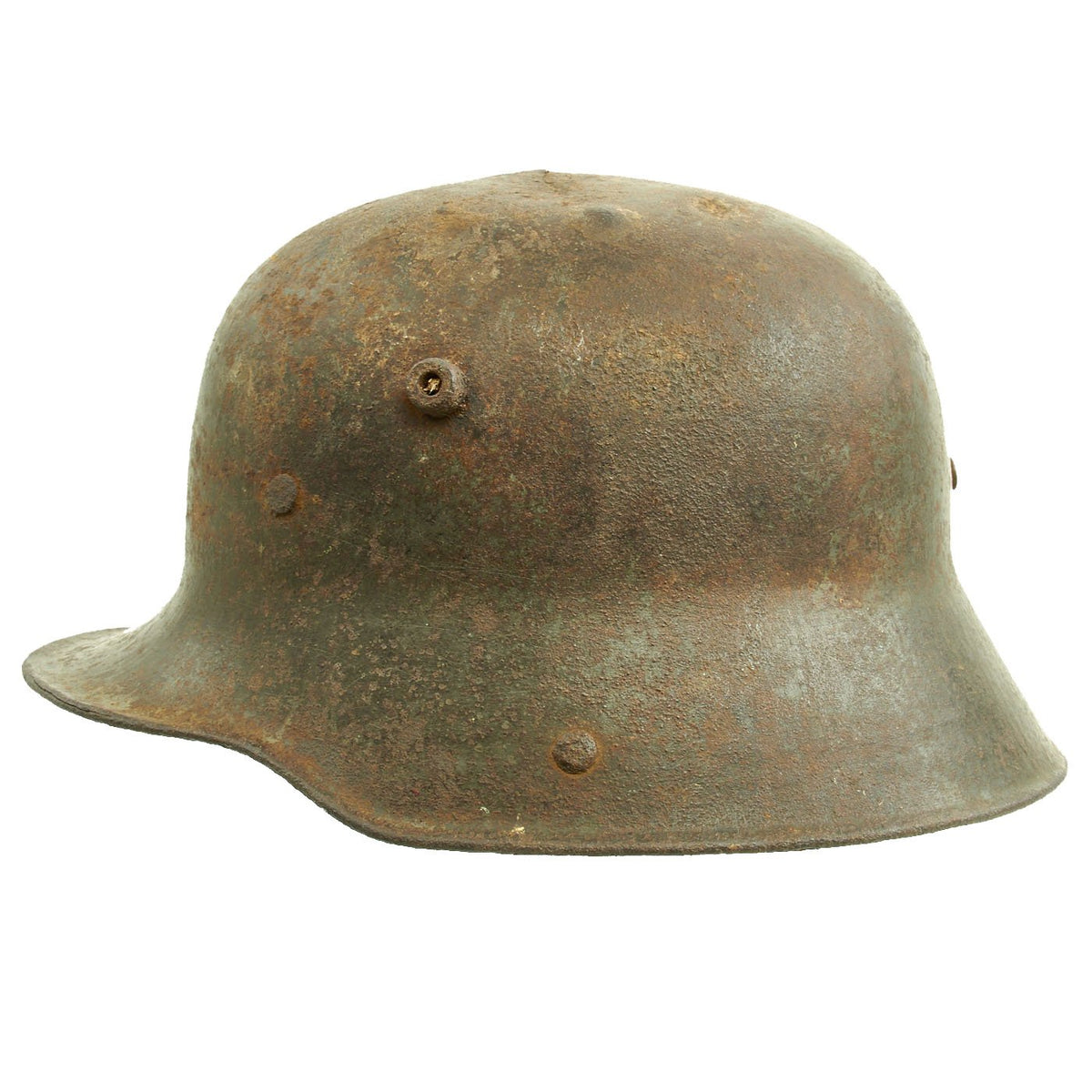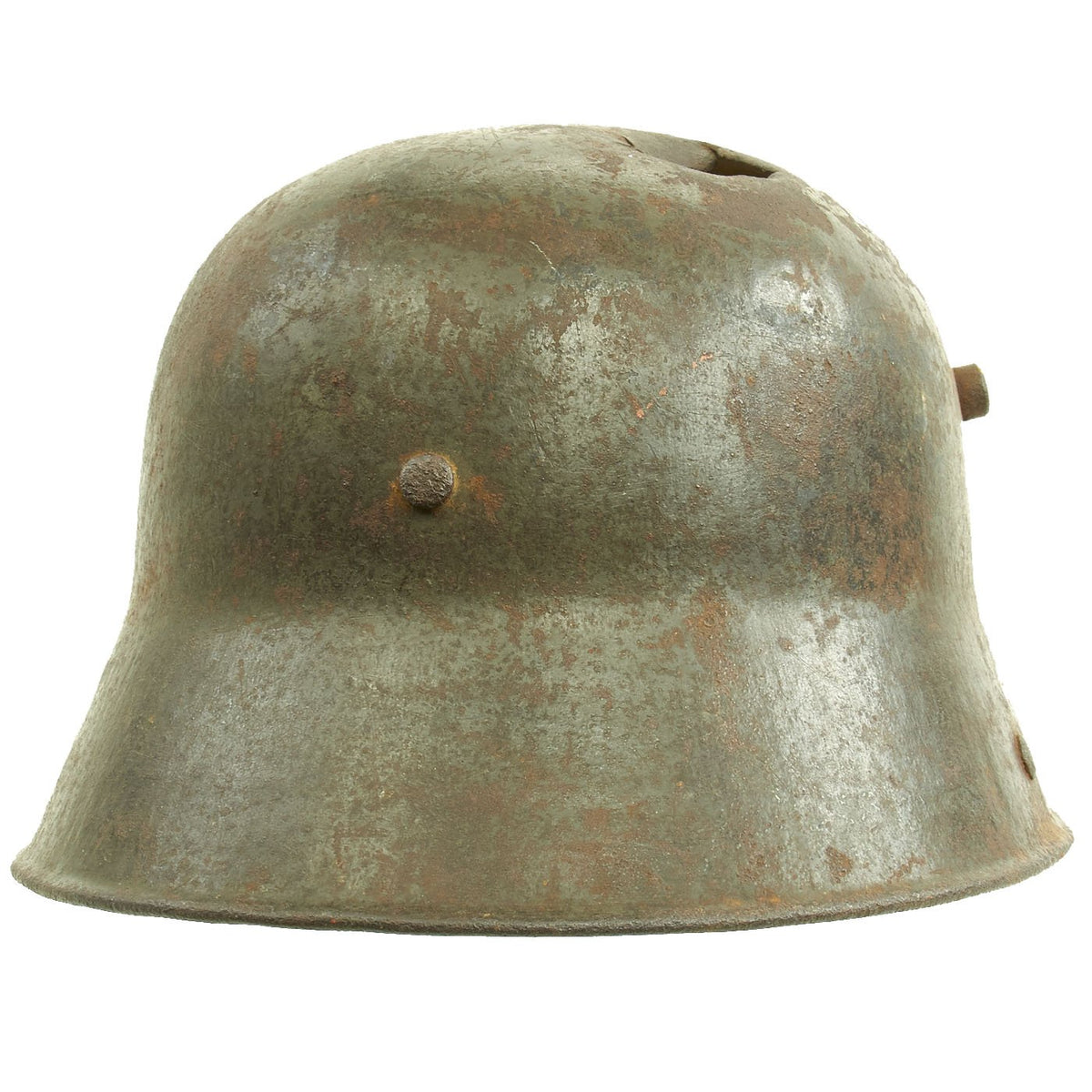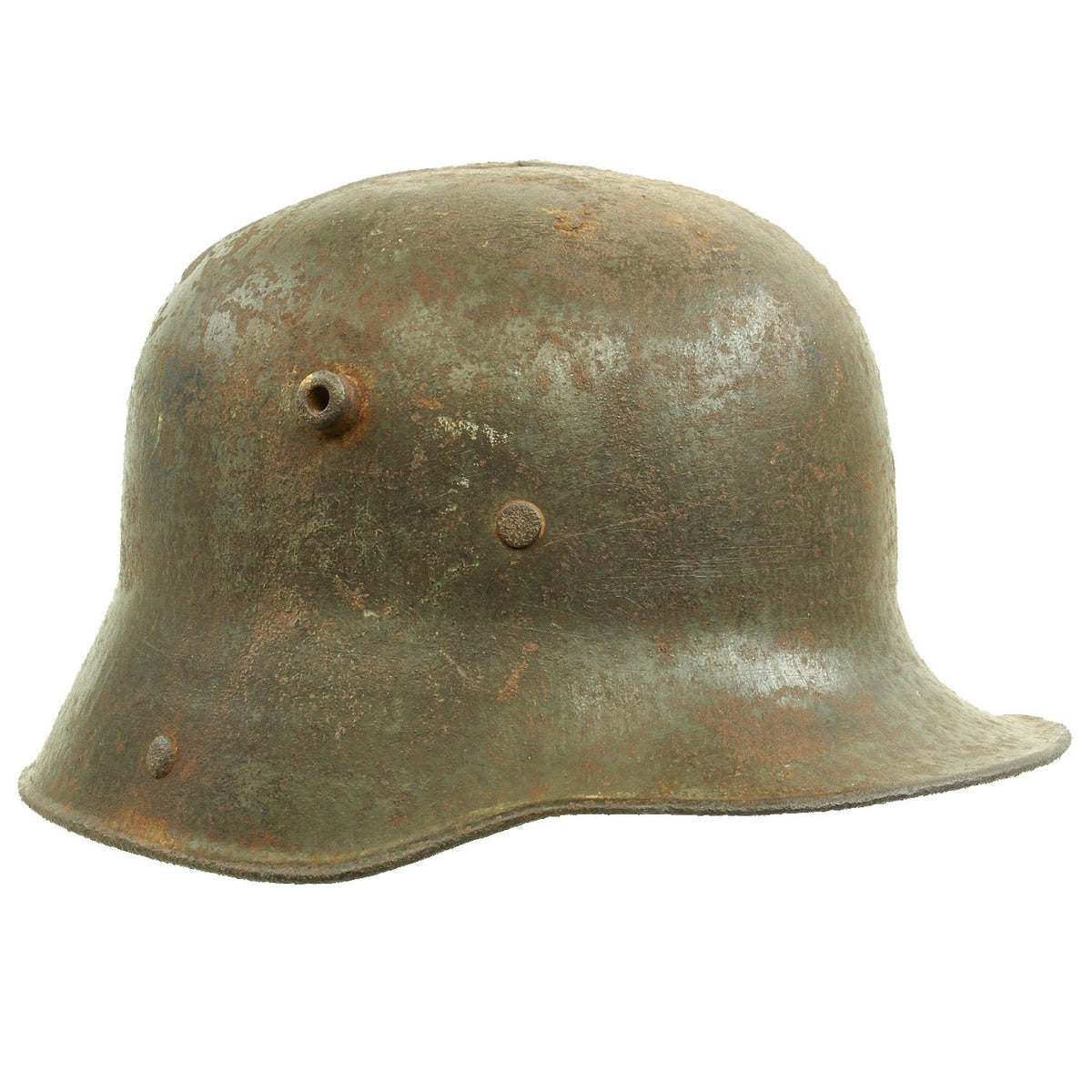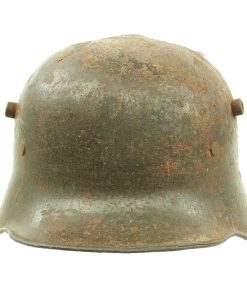Original German WWI Battlefield Pickup M16 KIA Shot Through Helmet with Partial Liner – Size 66 Shell Original Items
$ 495,00 $ 148,50
Original Item: Only One Available. This is an amazing example of a totally original WWI German M16 Helmet Shell, which was “Shot Through” long ago, almost certainly killing the wearer. It was then left on the battlefield for a while, which resulted in deterioration of the liner and rust damage on the inside, giving it that great “dug up” look.
The stamped, sheet steel construction, helmet retains a good amount of the original olive green paint on the exterior, standard for German WWI Helmets. The helmet shell still has has both the dome headed chinstrap retaining rivets, with their internal chin strap mounting washers. It still has both of the extended ventilation side lugs for the attachment of a stirnpanzer, and they are the correct shorter version without a step for size 66 shells. The helmet also retains three of the flat-headed liner retaining rivets, with the correct thicker rear rivet. These hold in place an original metal liner band, which is now rusted, with two of the three panels still present, though they are definitely degraded due to exposure and age.
The top of the helmet has a large hole, with cracking around it, which is what we typically see from a high power bullet strike or possibly shrapnel from a high explosive shell. There is another hole next to a 2 inch long crack, and there are some additional dents. There is even a dent from the inside, so this helmet may have been exposed to additional incoming fire after it was left on the field. Close inspection of the paint, style and aging of the edges lead us to be very confident that this totally 100% genuine.
The inside of the shell unfortunately has a lot of surface rust, so we are no longer able to see the maker code, but we definitely can see the size 66 marked on the left inside by the chin strap lug. Size 66 is a hard to find large size that can accommodate liners from 58cm to 60cm or US 7 1/4 to 7 1/2. Size 66 shells are always hard to find and are therefore more valuable to a collector. We unfortunately cannot see any type of dome stamp on the top inside of the shell.
With the recent 100-year anniversary of the close of world war one, this helmet, offered in great collectible condition, is a perfect addition to any Great War collection.
History of the M16
The Stahlhelm was introduced into regular service during the Verdun campaign in early 1916.
The M1916 design had side-mounted horn-like ventilator lugs which were intended to be support for an additional steel brow plate or Stirnpanzer, which only ever saw limited use by snipers and trench raiding parties, as it was too heavy for general use.
The shell came in different sizes, from 60 to 68, with some size 70s reported. The suspension, or liner, consisted of a headband with three segmented leather pouches, each holding padding materials, and leather or fabric cords could be adjusted to provide a comfortable fit. The one-piece leather chinstrap was attached to the shell by M1891 chinstrap lugs, the same kind used in the Pickelhaube helmet.
The M1916 design provided excellent protection: Reserve Lieutenant Walter Schulze of 8th Company Reserve Infantry Regiment 76 described his combat introduction to the helmet on the Somme, 29 July 1916:
“… suddenly, with a great clanging thud, I was hit on the forehead and knocked flying onto the floor of the trench… a shrapnel bullet had hit my helmet with great violence, without piercing it, but sufficiently hard to dent it. If I had, as had been usual up until a few days previously, been wearing a cap, then the Regiment would have had one more man killed.”
But the helmet was not without its flaws. The ventilator horns often let cold air in during the winter, requiring the wearer to block the vents with mud or fabric. The large, flared skirt tended to make it difficult for soldiers to hear, distorting surrounding sounds and creating an echo when the wearer spoke.
Originally painted Feldgrau (field grey), the Stahlhelm was often camouflaged by troops in the field using mud, foliage, cloth covers, and paint. Official issue cloth covers in white and grey appeared in late 1916 and early 1917. Camouflage paint was not formally introduced until July 1918, when German Army Order II, No 91 366, signed by General Erich Ludendorff on 7 July 1918, outlined official standards for helmet camouflage. The order stipulated that helmets should be painted in several colors, separated by a finger-wide black line. The colors should be relevant to the season, such as using green, brown and ocher in summer.
After the effectiveness of the M1916 design was validated during the 1916 campaigns, incremental improvements were subsequently made.
Fast Shipping with Professional Packaging
Thanks to our longstanding association with UPS FedEx DHL, and other major international carriers, we are able to provide a range of shipping options. Our warehouse staff is expertly trained and will wrap your products according to our exact and precise specifications. Prior to shipping, your goods will be thoroughly examined and securely secured. We ship to thousands clients each day across multiple countries. This shows how we're dedicated to be the largest retailer on the internet. Warehouses and distribution centres can be located throughout Europe as well as the USA.
Note: Orders with more than one item will be assigned a processing date depending on the item.
Before shipping before shipping, we'll conduct a thorough inspection of the items you have ordered. Today, the majority of orders will be delivered within 48 hours. The delivery time will be between 3-7 days.
Returns
The stock is dynamic and we cannot completely manage it because multiple stakeholders are involved, including our factory and warehouse. So the actual stock may alter at any time. It's possible that you may not receive your order once the order has been made.
Our policy is valid for a period of 30 days. If you don't receive the product within 30 days, we are not able to issue a refund or an exchange.
You can only return an item if it is unused and in the same state as the day you received it. You must have the item in its original packaging.
Related products
Uncategorized
Australian WWII Owen MK1 Machine Carbine SMG Custom Fabricated Replica with Sling Original Items
Uncategorized
Uncategorized
Uncategorized
Uncategorized
Armoured Fighting Vehicles of the World: AFVs of World War One (Hardcover Book) New Made Items
Uncategorized
Uncategorized
Armored Burgonet Helmet & Polearm from Scottish Castle Leith Hall Circa 1700 Original Items
Uncategorized
Uncategorized
Uncategorized
Uncategorized
Uncategorized
Band of Brothers ORIGINAL GERMAN WWII Le. F.H. 18 10.5cm ARTILLERY PIECE Original Items
Uncategorized
Angolan Rebel 1970s era 60mm Inert Display Mortar from Angolan Civil War Original Items
Uncategorized
Uncategorized
Uncategorized
Uncategorized
Uncategorized












































































